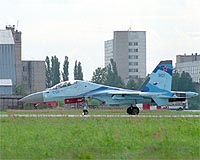 Sukhoi Su-35 Flanker
Sukhoi Su-35 Flanker
Moscow - July 25, 2008 The Sukhoi Su-35 Flanker is not quite a fifth-generation combat fighter, but it comes very close to being one.
Under current plans, Russia will not be producing a fifth-generation air superiority fighter until 2015. However, the technical characteristics of the Sukhoi Su-35BM are high enough to fulfill this task, outmatching all the modern American, French and European Union generation 4-plus fighter designs, including the Super Hornet, Rafale and Typhoon. The Sukhoi Su-35 is able to withstand even the world's only fifth-generation fighter now in production, the F-22, though it is much cheaper than the American fighter -- its cost is around $40 million, compared with $300 million for the F-22.
Regarding the Russian Defense Ministry's plans, the question emerges whether Russian industry would be capable of launching production in the required numbers within the scheduled period. The answer is more likely to be positive: The industrial capacities are beyond doubt, as the production of numerous modifications of Sukhoi Su-27s and Sukhoi Su-30s for export is on the rise. What the program requires is uninterrupted state funding.
With the Sukhoi Su-35 launched into mass production in 2011, the 182 aircraft ordered by the Russian Defense Ministry would be delivered by 2020. By that time the Russian air force would have between 120 and 140 upgraded Sukhoi Su-27s and 30 to 40 fifth-generation fighters, enabling the air force to maintain its combat potential in the next two to three decades.
There have been many successful designs in the history of aviation, but only a few could match rising combat requirements for a number of years, like the famous piston-engined Messerschmitt Bf-109 and North American P-51 Mustang air superiority combat fighters of World War II, the Tupolev Tu-95 Bear and Boeing B-52 Stratofortress strategic bombers, and the Sukhoi Su-27. The T-10 prototype made its maiden flight in 1977 and another flight in 1981 after major improvements.
The fighter went into mass production as late as 1984, and it still has the combat potential sufficient to remain one of the world's best aircraft. The Sukhoi Su-35BM, taking to the skies in 2008, showed even higher performance, an unprecedented improvement on a design developed 30 years ago.
It's not easy to forecast what lies ahead for the Sukhoi Su-35, but no doubt it will live through a few decades of service with gradual renewal of armament and avionics, until the moment when this fighter, along with more sophisticated aircraft, will be replaced by aerial vehicles based on new physical principles.
(Ilya Kramnik is a military commentator for the RIA Novosti news agency. This article is reprinted by permission of RIA Novosti. The opinions expressed in this article are the author's and do not necessarily represent those of RIA Novosti.)
(United Press International's "Outside View" commentaries are written by outside contributors who specialize in a variety of important issues. The views expressed do not necessarily reflect those of United Press International. In the interests of creating an open forum, original submissions are invited.)
No comments:
Post a Comment